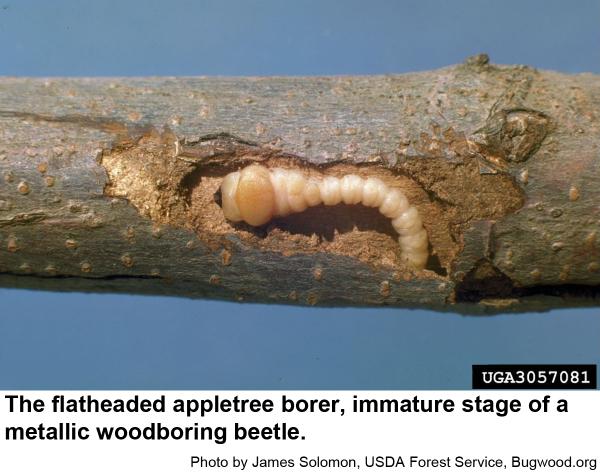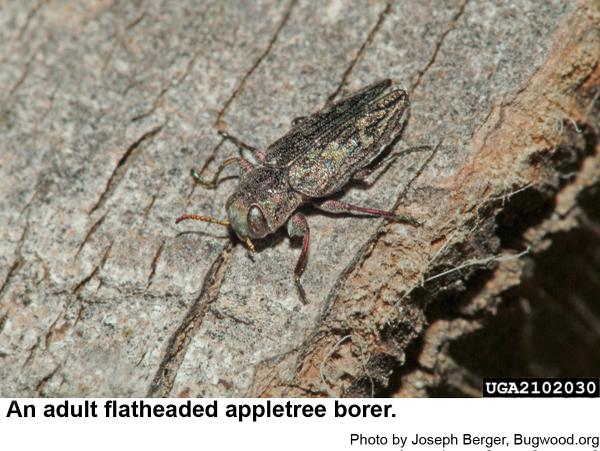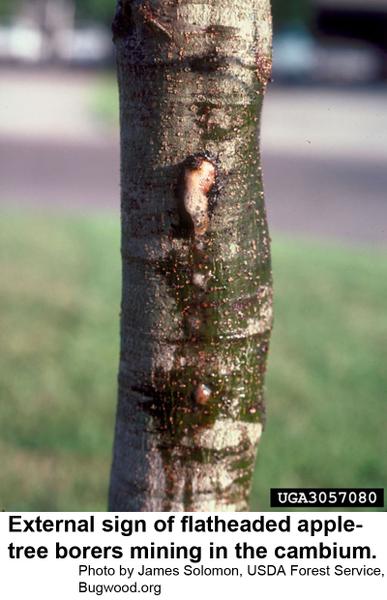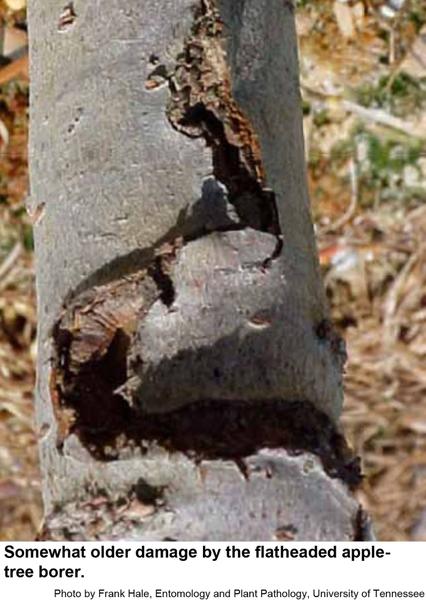Description and Biology
The flatheaded appletree borer, Chrysobothris femorata, and other closely related flatheaded borers are attracted to weakened trees. This borer is so called because the thoracic segments are noticeably wider than the rest of the slender, segmented grub, and their damage often occurs on apple. Adult flatheaded appletree borers are called metallic woodboring beetles because many species are beautifully metallic. This species is somewhat shiny and gray to bronze on top; the lower surfaces are clearly metallic and greenish. These beetles are shaped like a sunflower seed in top view and are 1/2 to 3/4 inch long. Adults appear throughout the summer and lay orange to reddish brown, flattened, broadly oval eggs under bark scales or in crevices of the main trunk and larger branches. The grubs bore into the bark and feed in the phloem and outer sapwood. Their tunnels are sometimes three inches long or more especially in young trees. Drought or defoliation or some other stress may cause trees to become susceptible to flatheaded borers.
Host Plants
Flatheaded appletree borers has a wide host range of deciduous trees especially those with thin bark such as young apples, crabapple, crapemyrtle, dogwoods, hawthorn, linden, maples and oak. These borers are particularly troublesome in commercial nurseries and urban landscapes.
Residential Recommendations
Trees newly set out in the landscape may be particularly susceptible to flatheaded borers. Such trees should be protected by pyrethroid insecticides during their first year or two in the landscape or the trunk should be wrapped in some sort of tree wrap to prevent adult flatheaded borers from ovipositing on the stressed trees. Imidacloprid and perhaps other systemic insecticides can be applied to the soil around susceptible trees from February to April although it would be a good idea to spray the trunks and larger branches with a pyrethroid as well. These insecticides are available in the plant centers of most big box stores and nurseries. Mulch and keep newly planted trees and shrubs sufficiently watered. When used as directed, pyrethroids are very toxic to insects but are not particularly hazardous to humans and pets (other than fish-avoid using pyrethroids around pools, ponds, and streams).
Other Resources
- Flat-headed apple tree borer. Anonymous. 2015. Michigan State University Integrated Pest Management.
- Flatheaded appletree borer. Krischik, V. and J. Davidson. 2013 (last modified). Pests of Trees and Shrubs, IPM of Midwest Landscapes.
- Identifying the Flatheaded Appletree Borer (Chrysobothris femorata) and Other Buprestid Beetle Species in Tennessee. 2011. Hansen, J. A., F. A. Hale, and W. E. Klingeman. University of Tennessee Extension SP503-1.
- Insects of Eastern forests. Drooz, A. T. editor. 1985. USDA Forest Service Misc. Publication 1426. 608 pp.
- Extension Plant Pathology Publications and Factsheets
- Horticultural Science Publications
- North Carolina Agricultural Chemicals Manual
For assistance with a specific problem, contact your local N.C. Cooperative Extension Center.
This Factsheet has not been peer reviewed.
Publication date: Nov. 15, 2018
Reviewed/Revised: Sept. 16, 2019
Recommendations for the use of agricultural chemicals are included in this publication as a convenience to the reader. The use of brand names and any mention or listing of commercial products or services in this publication does not imply endorsement by NC State University or N.C. A&T State University nor discrimination against similar products or services not mentioned. Individuals who use agricultural chemicals are responsible for ensuring that the intended use complies with current regulations and conforms to the product label. Be sure to obtain current information about usage regulations and examine a current product label before applying any chemical. For assistance, contact your local N.C. Cooperative Extension county center.
N.C. Cooperative Extension prohibits discrimination and harassment regardless of age, color, disability, family and marital status, gender identity, national origin, political beliefs, race, religion, sex (including pregnancy), sexual orientation and veteran status.





